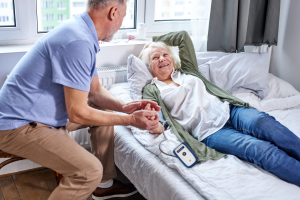Why Risk it? A Case Against Bed Rails for Fall Management

Why risk it?
A case against bed rails for fall management
By Bill Bulzoni
When it comes to resident safety, bed rails, also known as side rails, seem like a logical and effective form of fall prevention and fall management for those at risk of falling in senior living communities.
In reality, they can be extremely dangerous. Fall management is a top priority when it comes to keeping our seniors safe.
The Problem
Bed rails, usually made out of plastic or metal, come in two types: those that are stationary, or those that can be moved up and down. Residents can use bed rails to help themselves turn over, pull themselves up, or get out of bed.
But bed rails can actually cause more problems for seniors, especially those that are frail, injured, or suffer from diseases like Alzheimer’s or other memory-based ailments.
There are two major dangers:
- Strangulation and suffocation. Seniors can get trapped in the gap between the bed rail and the mattress, and unfortunately may be too weak, frail, or confused to free themselves. Sometimes, seniors get trapped between the bed rails and suffocate. If they’re stuck, the mattress may press against their chest, which could cause strangulation and even death.
- If residents are confused or have a memory-based disease such as Alzheimer’s, they could try to climb over the bed rails to get out of bed. They may trip and fall, causing head injuries, cuts, abrasions, and bruises. Injuries can even be worse from crawling over the bed rails because of the longer fall.
Daunting Statistics
- The Food and Drug Administration (FDA), which qualifies bed rails as “medical devices,” has received more than 900-bed rail-related reports since 1985. And even more shocking: 531 deaths. Reports include patients or residents being trapped, entangled, caught, or strangled.
From 2003 to 2012, the Consumer Product Safety Commission (CPSC) documented 160 incidents caused by portable bed rails. Using nationwide data from death certificates and hospital emergency room visits, the report found 155 deaths were caused as a result of bed rails.
- More than 120 of those who died were 60 or older
- 25% of deaths occurred at a skilled nursing or assisted living community
- Most of the 155 deaths occurred as a result of a person’s head or neck getting caught or stuck in the bed rails
- One-half of those that died in bed rail accidents had memory-based ailments like dementia or other medical problems such as heart disease or Parkinson’s disease
And yet, there are not nearly as many federal bed rail safety regulations for adults as there are for children. Even though bed rails have caused deaths among seniors, especially those over age 60, the products have not been recalled or taken off the market.
Making a Change
In July 2013, the CPSC was asking for support on a petition calling for a total ban on adult portable bed rails. The CPSC petition was merged from two petitions: one from the non-profit lobbying group, Public Citizen, and the other from the Consumer Federation of America and the National Consumer Voice for Quality Long-Term Care, dubbed “The Consumer Group” petition. More than 60 organizations signed the latter petition.
If the CPSC does not put a full ban in place, The Consumer Group petition is calling for strict standards on bed rail design, safety reviews, and warning labels.
If bed rails are removed completely, then providers will have to look at alternatives for residents associated with a high risk for falls. Luckily, in today’s growing market, there are many options available.
A Wireless Solution
Providers can use products that greatly reduce the risks associated with bed rails, and also effectively communicate with staff members if a patient at risk needs to get up from a bed or chair.
Wireless fall management alarm systems are a reliable fall management option that typically uses very few components that are not a risk to a resident’s safety or comfort. Seek out a solution that is:
Simple. Some fall management alarm systems use just two components: an alarm unit and a bed or chair sensor pad that easily connects to the alarm unit. For caregivers, the system is easy to set up and use.
Restraint-free. Instead of bed rails, the sensor pads do the work. When weight is removed from the pad, such as a resident attempting to get up from his/her bed, an audible alarm will sound at the device to alert caregivers. This method helps reduce the risk of falls while protecting residents’ dignity.
Automated. The best solutions start monitoring as soon as weight is applied to the sensor pad. Most often, indicator lights on the alarm unit will let caregivers know that the system is in “monitor” mode.
Customizable. Because all residents are unique, look for an alarm unit that has adjustable features such as volume and alarm delay. Setting an alarm unit to a low volume helps reduce alarm fatigue and can provide safety without creating a noisy living environment. An adjustable alarm delay feature enables staff members to tailor each unit to a resident’s level of fall risk. If certain residents tend to shift or move around in bed, set the alarm delay to four or five seconds instead of one second to avoid false alarms. Multiple pad types that last anywhere from seven days to half a year are also a plus.
Multi-functional. The best alarm units are capable of integrating with a bedside nurse call system, giving residents one more way to call for help. If your community uses a central computer station and the call cord is pressed, the nurse call integration feature will generate a silent, local alarm and send a notification to the computer. This feature can greatly contribute to a quieter, more home-like environment.
Choosing a Solution
A fall management system is an essential asset to your community and residents, as well as a clear demonstration of your community’s dedication to resident care. An effective system should decrease the risk of falls and bring peace of mind to your residents and their families. Bed rails can actually increase the risk of falls and even cause injury and death.
Because it’s also a valuable investment, be sure you investigate your options and ask vendors questions. Take the time to select a reliable solution that is best for your residents and staff members, supporting your community’s fall management program for years to come.
References:
The National Consumer Voice for Quality Long-Term Care. https://www.theconsumervoice.org/sites/default/files/ConsumerVoiceBriefBed rails.pdf.
Chicago Tribune. July 11, 2013, article by Julie Deardorff. https://articles.chicagotribune.com/2013-07-11/news/ct-met-bed-rail-safety-20130707_1_rails-bed-medical-devices.
